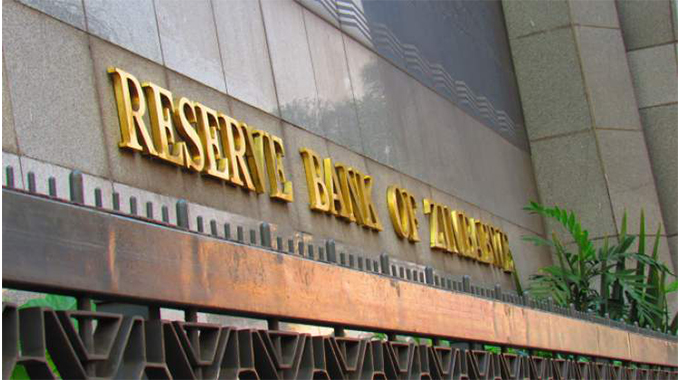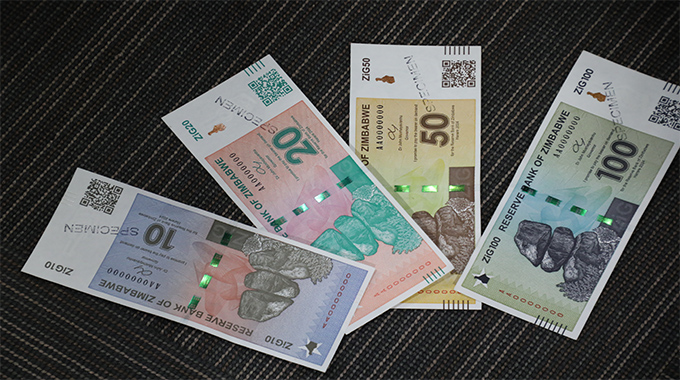‘Let’s believe in ZiG’…No going back to hyper inflation: Governor

Patrick Chitumba, [email protected]
THE newly introduced Zimbabwe Gold (ZiG) currency has the potential to deliver lasting stability, as it is the product of collective consultation and all stakeholders must embrace it to boost domestic economic transformation, Reserve Bank of Zimbabwe (RBZ) Governor, Dr John Mushayavanhu, has said.

Reserve Bank of Zimbabwe
The currency, which is backed by gold and foreign currency reserves, is aiming to curtail inflation and restore durable macro-economic stability, with the multicurrency regime set to stay in place until at least 2030.
Dr Mushayavanhu said rebuilding trust in the banking system is key to its success, adding that stakeholders should be positive about ZiG’s prospects.
Addressing business leaders at a Zimbabwe National Chamber of Commerce (ZNCC) organised meeting in Gweru yesterday to unpack the new Monetary Policy Statement (MPS), Dr Mushayavanhu said building market confidence and trust in the new currency was a collective duty of all Zimbabweans.
Two weeks after its official launch, the new currency remains stable with major business players and consumers across the country smoothly conducting transactions following the successful conversion of Zimbabwe dollar balances, amid marginal gains against the United States dollar.
Coming from a background of wild exchange rate volatility, price escalation and speculative market, the new currency is promising to reverse the tide as monetary authorities maintain the multicurrency regime, while paving the way for de-dollarisation in the long-term.
The ZiG replaced the inflation-hit Zimbabwe dollar, which had fallen to around $33 000 against US$1 on the interbank market and traded above $40 000 to US$1 on the parallel market.

ZiG notes
“People need to trust the banking system again, so that they can save and bank their money again. I am saying there will not be any room for excessive printing of money because that causes inflation,” said Dr Mushayavanhu.
“Under my watch, there is not going to be any printing of money in excess of the gold that the Central Bank has.
“That’s a cardinal rule at the Central Bank and we have systems that we are putting in place to make sure that we don’t break that cardinal rule. If that happens (excess printing of money) under my watch, please crucify me.”
Dr Mushayavanhu said the structured currency is anchored by a composite basket of currency and precious metals, mainly gold, held as reserves for this purpose, by the Reserve Bank.
Government has set aside 2,5 tonnes of gold and US$300 million in cash reserves to back the new currency, placing it in good stead to command solid stability. “Of the 2,5 tonnes, 1,5 tonnes is held in the Central Bank’s vaults, with one tonne held offshore.
“So, each year, we are going to have independent auditors coming in to audit the gold and the foreign currency reserves we have that back ZiG.
“We had President Mnangagwa and the media at the RBZ to see the gold reserves we have that are 2,5 tonnes and US$300 million that are backing ZiG,” said Dr Mushayavanhu.

President Mnangagwa
“We are confident that ZiG is going to address exchange rate volatility, curtail inflation and restore durable macro-economic stability as the country works on doing away with the multicurrency regime by 2030.
“Since April 6, ZiG is actually stronger and remember it is backed by gold, and forex reserves that we have. You can go into a bank and buy ,or go in and sell foreign currency.
“There is a need for us to be positive about ZiG because there is no gain in attacking the ZiG, to anyone. We need to start believing in it, it won’t benefit you soiling the new currency, it won’t benefit the next generation either.”
The newly appointed RBZ Governor said a lot of consultation was done prior to the introduction of ZiG, during which economic players such as the Confederation of Zimbabwe Industries (CZI), and other key representative organisations made huge contributions towards its invention.
“Consultations before the MPS were made, yes. In fact, my appointment was announced on December 8, but His Excellency had told me on September 11 that I was going to be the Governor of RBZ.
“So, I started working as Governor from as far back as September 11 and we consulted far and wide. We didn’t come to Gweru, but we spoke to the Chamber of Mines, ZNCC, Retailers Association, CCZ, and you will be surprised to note that most of the input came from the stakeholders,” said Dr Mushayavanhu.
“We borrowed a lot from a paper that was presented by CZI. We didn’t invent ZiG; it was invented by CZI. They are the ones who said to us that when we look at the amount of RTGS/bonds in circulation, if we convert them, we can buy it all and start afresh. “This came from CZI and so we consulted far and wide.”
The Apex Bank boss assured the business community that the Reserve Bank operations were independent with no Government interference as clearly spelt out in the RBZ Act.
“We are not subject to interference by the Ministry of Finance and Economic Development. I want to assure you that when I went to the Central Bank, the first thing I was interested in was to confirm whether or not the Ministry of Finance was dipping into the coffers of the Central Bank whenever they felt like it,” he said.
“I could not find an occurrence when the ministry used its overdraft facility whenever they wanted. The Ministry of Finance is running a surplus budget and if anything, we handle their deposits and we see how they are running their accounts every day,” said Dr Mushayavanhu.
He reiterated that the idea behind the MPS was to make sure that the people accept ZiG, adding that the over 15 million Zimbabweans stand to benefit more if there is buy-in from everyone.
“Once we do that, we create a currency that is acceptable. Remember with the currency we had in the past, as soon as one got the RTGS in the account, they made sure that by the end of the day they would have changed it to US dollars at whatever price.
“But we want to create a currency that is stable, which you can sell and that way you see people banking the extra money they have and start building up towards something they will be investing in.”
Guided by the new MPS, the RBZ has said the market forces will drive ZiG with the bank riding on the willing buyer/willing seller platform.
Concerning businesses that refuse ZiG such as fuel service stations, Dr Mushayavanhu said the time is coming when such entities have to meet 50 percent of their tax obligation by June this year and they will be looking for ZiG.
“At the moment 80 percent of all trade is being made in US dollars, while 20 percent is in local currency. We want to move to 70:30 by the end of next year then to 60:40, 50:50 as the years progress through the structured roadmap we have laid so that we gradually promote increased use of the new local currency as the nation moves towards 2030,” he said.
CCZ representative Ms Chiedza Runashe commended the introduction of ZiG as a positive development that would deliver confidence to the local currency.
She urged the Government to consolidate policy measures that create higher demand for the local currency for market players to follow suit, weed out price discrimination and distortion for the benefit of ordinary consumers.
Economist Mr Trust Chihohora said there is a need to restore market confidence in the wake of ZiG and urged the Treasury to refine fiscal policy to buttress ZiG’s success.
Bata Shoe Company country manager, Mr Simon Mutisiya, said manufacturers need incentives to be able to reach maximum optimisation.
“Right now we are just trying to stay afloat because of the current economic outlook, we expect the performance of the economy to improve with the introduction of ZiG,” he said.
“The policy ought to look and change how and where Government departments purchase, for example gumboots. We also need to be supported by, say the police buying from Bata.”










Comments